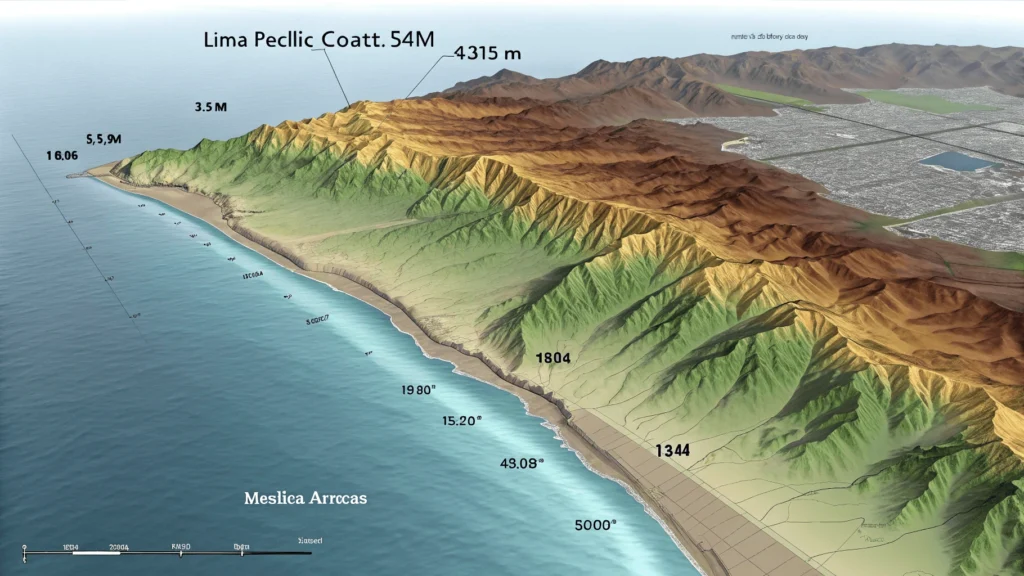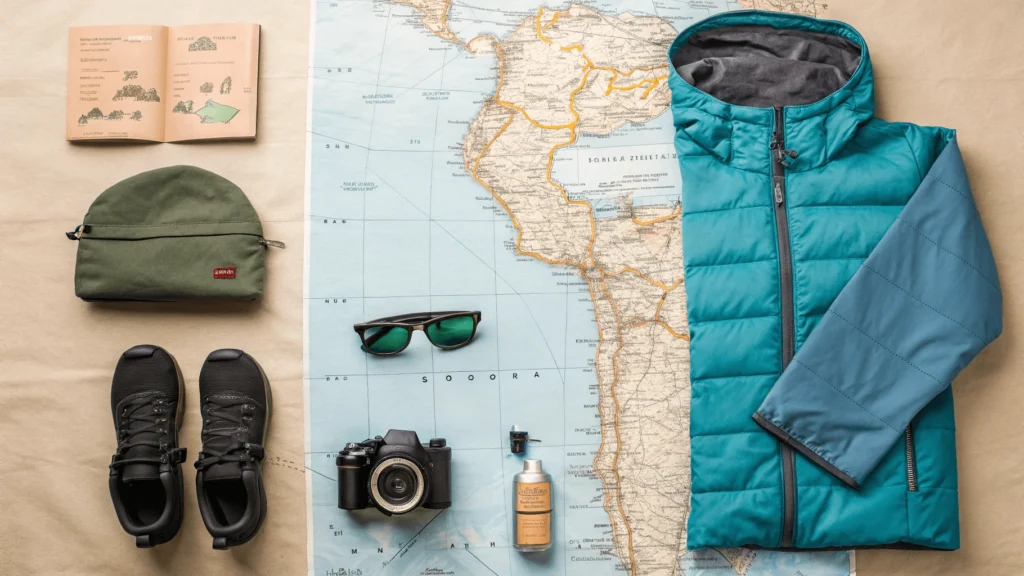Introduction
Planning a trip to Peru? You’ve probably heard about the dizzying heights of the Andes, but what about the capital city where your journey will likely begin?
Lima, the vibrant capital of Peru, sits comfortably at sea level, with an average elevation of just 154 meters (505 feet) above sea level.
This low altitude makes Lima the perfect starting point for your Peruvian adventure. While many travelers focus on reaching Machu Picchu or exploring Cusco, understanding Lima’s elevation is crucial for planning a comfortable and enjoyable trip. In this guide, we’ll explorelima peru elevation in detail, compare it to other Peruvian destinations, discuss its significance for avoiding altitude sickness, and provide practical tips for making the most of your time in this coastal capital before venturing to higher ground.
Table of Contents
Understanding Lima’s Elevation in Detail

Lima’s average elevation of 154 meters (505 feet) above sea level classifies it as a low-altitude coastal city. While there are slight variations across Lima’s sprawling metropolitan area—with some districts directly on the coast and others situated on gentle hills slightly inland—these differences are negligible when considering potential altitude effects on travelers. (lima peru elevation)
The city stretches along Peru’s central coastline, with the Pacific Ocean forming its western boundary. This geographic positioning explains Lima’s sea-level lima peru elevation, which stands in stark contrast to Peru’s numerous high-altitude destinations in the Andes mountains further inland. (lima peru elevation)
Why Lima’s Low Elevation is Crucial for Travelers
The “Sea-Level Advantage”
Lima’s position near sea level offers several significant benefits for international travelers:
- No risk of altitude sickness while in the capital
- An ideal “soft landing” for those arriving on international flights
- Allows your body to rest and recover from travel before potentially ascending to higher lima peru elevation
- Provides time to adjust to the local time zone without additional physical stress

The Gateway to the Andes
Lima serves as Peru’s primary international entry point and the typical first stop before heading to high-altitude destinations. This strategic position allows travelers to gradually prepare for the dramatic lima peru elevation changes that await them elsewhere in the country.
Contrast is Key (lima peru elevation)
To truly appreciate the significance of Lima’s elevation, consider how it compares to other major Peruvian destinations:
| Destination | Elevation (meters) | Elevation (feet) |
|---|---|---|
| Lima | 154 m | 505 ft |
| Cusco | 3,399 m | 11,152 ft |
| Machu Picchu | 2,430 m | 7,972 ft |
| Sacred Valley (Urubamba) | ~2,870 m | ~9,416 ft |
| Puno (Lake Titicaca) | 3,827 m | 12,556 ft |
| Arequipa | 2,335 m | 7,661 ft |
| Huaraz | 3,052 m | 10,013 ft |
As this comparison shows, traveling from Lima to popular destinations like Cusco involves an elevation increase of over 3,000 meters (nearly 10,000 feet)—a significant change that can impact even the most seasoned travelers. (lima peru elevation)
Implications for Itinerary Planning
Understanding Lima’s low elevation helps structure a more comfortable Peru itinerary. Spending 1-2 days in Lima upon arrival allows you to: (lima peru elevation)
- Recover from international travel
- Begin adjusting to the local time zone
- Explore a fascinating city without altitude concerns
- Mentally and physically prepare for higher elevations
- Enjoy coastal activities and world-class cuisine before heading to the mountains
Lima & Altitude Sickness (Soroche): The Connection
Clarification
It’s important to emphasize that you cannot get altitude sickness in Lima itself. The city’s low elevation poses no risk for altitude-related symptoms, which typically begin at elevations above 2,500 meters (8,000 feet).
Preventative Role (lima peru elevation)
While staying in Lima doesn’t technically count as acclimatization to high altitudes, it does play a crucial preventative role in your journey. Starting in Lima means:
- Avoiding immediate exposure to high altitudes upon arriving in Peru
- Giving your body time to recover from travel fatigue, which can exacerbate altitude symptoms
- Creating a more gradual transition in your overall trip
Acclimatization Strategy (lima peru elevation)
For the smoothest possible journey, consider:
- Spending 24-48 hours in Lima upon arrival before flying to Cusco or other high-altitude locations
- Maintaining proper hydration while in Lima (a good practice to continue throughout your trip)
- Getting adequate rest to recover from travel
- Considering a gradual ascent approach—for example, visiting the slightly lower Sacred Valley before staying in Cusco
Altitude sickness, or “soroche” as it’s known locally, can cause symptoms ranging from headaches and nausea to more serious complications at high elevations. While Lima’s sea-level position prevents these issues, understanding altitude concerns becomes important as you plan the next stages of your Peruvian adventure.
The Centers for Disease Control and Prevention (CDC) provides detailed guidance on how to prevent and treat altitude sickness while traveling.
For comprehensive information about managing altitude sickness in Peru’s highlands, consider consulting resources from the CDC or speaking with a travel medicine specialist before your trip.
Practical Tips for Travelers Based on Lima’s Elevation
Packing
Lima’s coastal location means you won’t need specialized high-altitude gear while in the capital:
- Pack light, breathable clothing for Lima’s coastal climate
- Save space in your luggage for warmer layers you’ll need at higher elevations later
- Remember that Lima’s weather patterns differ significantly from those in the highlands
- Consider Lima’s seasonal conditions—humid and overcast in winter (May-October), warmer and sunnier in summer (November-April)

Activities in Lima
Take advantage of Lima’s comfortable elevation with activities like:
- Exploring the historic center (a UNESCO World Heritage site)
- Walking along the picturesque Miraflores cliffside and El Malecón
- Visiting coastal districts and beaches
- Enjoying the city’s renowned culinary scene
- Taking surfing lessons in the Pacific
- Exploring museums and archaeological sites without altitude concerns
Transitioning to Higher Elevations
When leaving Lima for higher destinations, prepare for the change:
- The flight from Lima to Cusco takes only about 1.5 hours but involves a dramatic lima peru elevation increase
- Consider bringing altitude sickness medication as a precaution (consult your doctor first)
- Plan for a lighter schedule during your first 24 hours at higher elevations
- Continue the hydration habits you established in Lima
Hydration and Diet
General wellness practices beginning in Lima will serve you well throughout your journey:
- Start hydrating well while still in Lima
- Moderate alcohol consumption, which can worsen dehydration
- Enjoy Lima’s world-class cuisine, but avoid excessive heavy meals before traveling to altitude
- Consider incorporating local coca tea into your diet once you reach higher elevations (though not in Lima, where it’s unnecessary) For background on coca tea’s traditional use and effects, the National Institutes of Health (NIH) provides insights into its cultural and medicinal context in the Andes.
Frequently Asked Questions
Is Lima Peru high altitude?
No, Lima is not at high altitude. At approximately 154 meters (505 feet) above sea level, Lima is considered a sea-level city.
Do you need to acclimatize in Lima?
No, acclimatization is not necessary in Lima due to its low elevation. However, spending time in Lima is advisable to rest before ascending to higher-altitude destinations in Peru.
Is altitude sickness common in Lima?
No, altitude sickness is not possible in Lima due to its sea-level elevation. Altitude sickness typically affects travelers at elevations above 2,500 meters (8,000 feet).
What is the elevation difference between Lima and Cusco?
The elevation difference between Lima and Cusco is approximately 3,245 meters (10,647 feet). Lima sits at 154 meters (505 feet), while Cusco is at 3,399 meters (11,152 feet) above sea level.
How high is Lima compared to Machu Picchu?
Lima is significantly lower than Machu Picchu. lima peru elevation is 154 meters (505 feet), while Machu Picchu sits at 2,430 meters (7,972 feet) above sea level—a difference of 2,276 meters (7,467 feet).
Should I fly directly to Cusco or stay in Lima first?
Most travelers benefit from staying in Lima for at least 24-48 hours before flying to Cusco. This allows time to recover from international travel and helps create a more gradual transition to high altitude.
Conclusion (lima peru elevation)
Lima’s elevation of 154 meters (505 feet) above sea level gives the Peruvian capital a significant advantage as the starting point for your Andean adventure. This coastal city provides international travelers with a comfortable introduction to Peru before the dramatic altitude changes that await in destinations like Cusco, Machu Picchu, and Lake Titicaca.
By understanding Lima’s sea-level position and its relationship to Peru’s higher-altitude attractions, you can plan a more strategic and enjoyable journey. Use Lima not just as a transit point but as a valuable opportunity to prepare both mentally and physically for the magnificent Andean landscapes that lie ahead.
Have you experienced the lima peru elevation contrast between Lima and Peru’s highland destinations? Share your experiences and questions in the comments below, or explore our other guides to planning the perfect Peruvian adventure!


